Em Theay - a national icon
I had the pleasure of meeting the legendary Em Theay this morning. And what a pleasure it was. She is such a gentle and graceful lady, she lives for her art and takes every opportunity to demonstrate the wealth of postures and movements that she learnt through her life and which she has passed onto countless students including her own daughters and their children. She is at the peak of a dynasty of classical performers and musicians and she shows no sign of taking it easy. She came to the new National Theatre, accompanied by her daughter Thong Kim Leng, herself a leading dancer, for an interview as part of Tim Sorel's documentary on Cambodia, thirty years after the fall of the Pol Pot regime. Tim interviewed Vann Nath at Tuol Sleng a couple of days ago and this morning, it was the turn of Em Theay, in my eyes a living national icon. Her interview was excellent, she simply couldn't stop herself from breaking into a toothless grin and displaying various stylised movements that she has practised throughout her life. I was there just to give a helping hand to director Tim Sorel and his translator Priya when required, but primarily to meet the lady known as the Tenth Dancer.
Here's a post from September 2006: After posting the Beyond the Killing Fields blog entry yesterday, I recalled that Em Theay was the main subject of a documentary I watched many years ago called The Tenth Dancer, which focused on the strength and resilience of the women of Cambodia in rebuilding their traditions from the fragments of a shattered society. The Khmer Rouge were responsible for the death or disappearance of over 90% of Cambodian artists, including most of the dancers of the Royal Ballet. Theay was one of the 10% to survive. The Tenth Dancer was made as long ago as 1993. Em Theay is still dancing and teaching today and performing abroad at the age of 75 years old - by anyone's reckoning that is a remarkable story.
Em Theay was chosen to dance at the age of seven by Queen Kossomak, for whom her parents worked as domestic servants. She grew up in the Royal Palace and was a dancer and singer in King Sihanouk's Royal Ballet until the Khmer Rouge took over her country. At that time she was forty-three and was sent to live in Battambang, where her talents didn't go unnoticed and her captors encouraged her to sing and dance as well as work in the fields. In 1975, twelve of her 18 children were alive. By the end of the KR period, seven had died and only five were left. Em Theay returned to Phnom Penh where her knowledge and skills of the traditional arts were put to use as a teacher at the National Dance Theatre and the Royal University of Fine Arts until quite recently. She is a vital link to Cambodia's past, quite literally a living national treasure and one that Cambodia should be tremendously proud of.
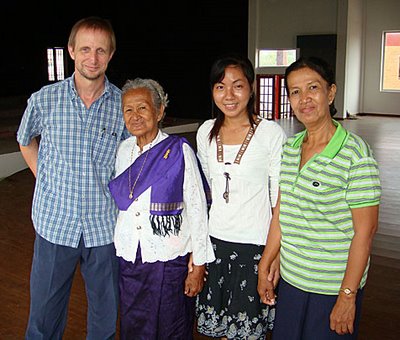 LtoR: The author, Em Theay, Priya and Thong Kim Leng
LtoR: The author, Em Theay, Priya and Thong Kim Leng
Here's a post from September 2006: After posting the Beyond the Killing Fields blog entry yesterday, I recalled that Em Theay was the main subject of a documentary I watched many years ago called The Tenth Dancer, which focused on the strength and resilience of the women of Cambodia in rebuilding their traditions from the fragments of a shattered society. The Khmer Rouge were responsible for the death or disappearance of over 90% of Cambodian artists, including most of the dancers of the Royal Ballet. Theay was one of the 10% to survive. The Tenth Dancer was made as long ago as 1993. Em Theay is still dancing and teaching today and performing abroad at the age of 75 years old - by anyone's reckoning that is a remarkable story.
Em Theay was chosen to dance at the age of seven by Queen Kossomak, for whom her parents worked as domestic servants. She grew up in the Royal Palace and was a dancer and singer in King Sihanouk's Royal Ballet until the Khmer Rouge took over her country. At that time she was forty-three and was sent to live in Battambang, where her talents didn't go unnoticed and her captors encouraged her to sing and dance as well as work in the fields. In 1975, twelve of her 18 children were alive. By the end of the KR period, seven had died and only five were left. Em Theay returned to Phnom Penh where her knowledge and skills of the traditional arts were put to use as a teacher at the National Dance Theatre and the Royal University of Fine Arts until quite recently. She is a vital link to Cambodia's past, quite literally a living national treasure and one that Cambodia should be tremendously proud of.
 LtoR: The author, Em Theay, Priya and Thong Kim Leng
LtoR: The author, Em Theay, Priya and Thong Kim LengTo read more about Em Theay's story and all about the documentary film, The Tenth Dancer, click here.
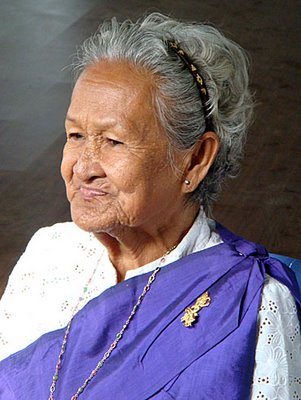
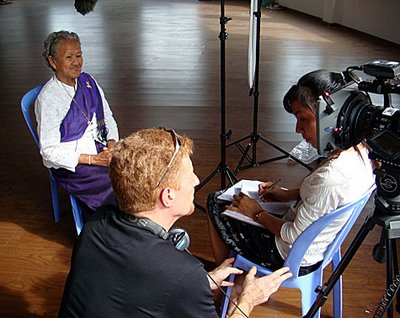
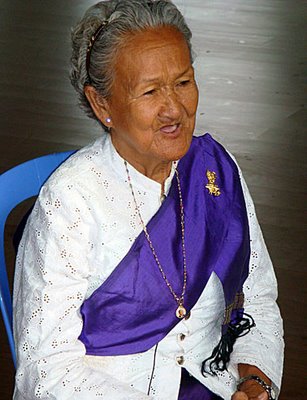
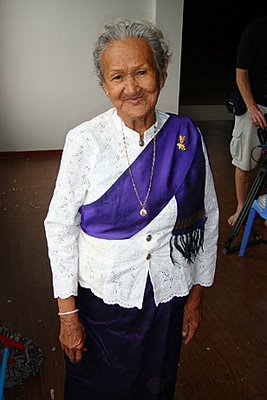


2 Comments:
Andy, are you leaving your blog at blogspot?
hi wanna,
more next week ok, stay tuned on my website.
andy
Post a Comment
<< Home